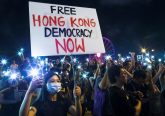In spite of their deep flaws, newspapers and broadcasters cannot be blamed for the toxic political environment that has taken over the country.
As any country with a minimally functioning democracy, Brazil has an ambivalent relationship with its mass media. And as in all countries with a minimally functioning market economy, Brazilian mass media have been disrupted by personalised digital platforms. Understanding To two elements, and how they became entangled, is essential if we are to grasp the role of the media in the social turmoil that has engulfed Brazil in the past year or so.
But in spite of their deep flaws, newspapers and broadcasters cannot be blamed for the toxic political environment that has taken over the country.
The picture is much more complex
For the first time in Brazilian history, the narrative of a major political crisis has been constructed by an incredibly fragmented media system. This challenges simplistic finger-pointing and affects the debate on who is morally responsible for the crisis.
Some initial caveats are in order. First, most of what I will say is based on my personal judgment and critical observation, not on proper scientific work. To my knowledge, no academic work (with some exceptions, as I note below) has explored these questions systematically. Second, my analysis will focus on the Operação Lava Jato (“Car Wash Operation”), arguably the immediate cause of the current political crisis, and will not address the ties between the media and the economic crisis – a dimension to the crisis which is at least as important as the political. Thirdly, my opinions are inevitably shaped by my previous experience as a journalist at Folha de S. Paulo, Brazil’s leading newspaper.
Nowadays, Brazil’s mass media is concentrated, weakened and much hated. There are three main national TV broadcasters: TV Globo, Record and SBT. Similarly, the print press, with a relatively tiny audience, is dominated by three standard papers: Folha de de S.Paulo, O Estado de S.Paulo and O Globo, the latter being owned by Globo Organisations. The weekly magazine market is even less dynamic. Only two publications (Veja and Época, the latter also a property of Globo) can claim to be relevant in terms of circulation. Newspapers and broadcasters have their own websites, with huge audiences. But, in spite of some interesting initiatives, there are no robust native online journalism companies.
We should also take into account that the Brazilian mass media (especially the print press) have been battered by huge financial difficulties in the past four years. Facing a general economic crisis, and their failure to compete with Facebook and Google for internet advertisements, newspapers and magazines (and some broadcasters) have made mass layoffs, letting go some of their most experienced reporters and editors.
If historical market concentration creates inter-company homogeneity, layoffs have deepened a kind of intra-newsroom homogeneity: fewer people, less diversity, fewer incentives for reporters to disagree with editors’ orders and for editors to resist top-down control. Unsurprisingly there has been a perceptible decline in technical quality (clarity of writing, informed analysis) and a shortage of manpower. Hiring young and inexperienced journalists, as some outlets have done, is not enough. Thus, the most important Brazilian political crisis in decades has been reported by a particularly weakened press.
This explains, in part, the kind of passive role mass media have had in the whole ‘Lava Jato’ coverage. I cannot remember a single major fact which was discovered by journalists during the scandal. What has been done so far is closer to ‘journalism about an investigation’ than ‘investigative journalism’. Reporters basically brought to the surface what federal policemen and prosecutors found. Even the typical dynamic of this kind of story, in which the ‘best’ reporters are those who have the best sources among the investigators, played a minor part in ‘Lava Jato’. This is because a good number of documents and rulings were made instantaneously public through an online system operated by the Judiciary. Disruptive transparency was the rule of thumb – a rarely analysed tactic that changed the scale of the scandal, as not only professional reporters had access to the documents.
Such relative passivity is not tantamount to neutrality – there is no such thing. Biases, however, come in all flavours.
Veja is at the extreme of the spectrum. In a downward editorial spiral for at least a decade now, the still powerful weekly resembles a cheap tabloid. It has published delirious and disgusting tales with the sole intention of personally attacking President Dilma Rousseff and her political mentor, former president Lula da Silva. Another embarrassing moment for Brazilian media occurred when GloboNews – a cable news channel also owned by Globo Organizations – cheerfully covered the massive anti-government protests in long, almost uninterrupted and uncritical live streaming. Globo’s Jornal Nacional, the most important daily TV news program in the country, has also spent a ridiculous amount of time exposing private telephone conversations between Rousseff and Lula that were secretly tapped and questionably made public by Sergio Moro, the judge who oversees the Car Wash Operation in the Federal Judiciary.
However, other outlets have been more balanced and their pro-impeachment positions more nuanced. The newspapers Folha de S.Paulo and O Globo, for instance, have been fiercely critical of the Speaker of the Lower House and Dilma’s nemesis, Eduardo Cunha. Folha published an editorial criticising Sergio Moro’s actions. Suspicions about government opponents have also received some attention by these publications.
There seems to exist among mass media owners a common perception that Rousseff is tragically inept, and that her impeachment, although not ideal and possibly not legal, could at least unlock the current paralysis faced by the government. But, in contrast to past historical events, such as the military coup that inaugurated the 1964-1985 dictatorship, mass media have been, in general, less partisan, less violent and more ambiguous.
Ironically, this has boosted criticism of all major outlets. For government supporters, mass media are guided by a classist prejudice against Lula (who is a former steelworker) and his alleged populist project. For anti-government actors, the mass media are on the government payroll, and their ambiguity about the necessity of impeachment is a capital sin.
Why all this suspicion?
First, Brazil, like many other countries, has seen the rise of an anti-establishment Zeitgeist. Such representational crisis also affects the media: who are they to say what is relevant? Some question. Second, Brazilian media have an awful record when it comes to defending democratic values, as the 1964 coup demonstrates. Third, people’s understanding of the news is as biased as the journalists’ creation of the news. We, the readers, understand what we want, and easily forget information which confronts our prejudices. Fourth, people now have a much more fragmented media ecosystem at their disposal.
Let me now turn to this last element, which I consider a critical component of the crisis.
Platforms: fragmented, strengthened, adored
To a large extent, the crisis has been experienced through and on digital platforms – which tells us something about the discontents, since more than 40% of Brazilian population has no access to the internet.
Granted, mass media have made the crisis a public ‘fact’. And this fact, in the form of hyperlinks to online articles and videos, have been a sort of official source of information, being shared, liked, forwarded and ‘memed’ millions of times. Here lies the ambivalence I mentioned in the beginning of this article: the same reader that hates Globo, for instance, eagerly uses Globo as a trustworthy source of news about the crisis.
It seems clear that professional journalists are the ones that have translated the investigation into a recognisable sequence of events, into a public, external, collective narrative. It is important, though, to notice that they ultimately have no control over this narrative. In fact, the very idea that there is one monolithic narrative about the crisis is ludicrous when one considers the insanely fragmented and complex mosaic we call social media.
Things have changed, dramatically. First, the Brazilian media landscape is populated by a myriad of highly politicised bloggers (some of them with ties to different parties and organised political groups). Present on all platforms, and representing all sides of the dispute, they have been quite active in unveiling alleged ‘media plots’ about specific facts by unearthing files produced by investigators, or sometimes by highlighting forgotten aspects of files already explored by mass media. These actions, on the one hand, aim to pull and bend newspapers’ and broadcasters’ narratives. They work as counter-narratives in their own right, which are also shared, liked, forwarded and ‘memed’ millions of times, commonly with additional interpretations by readers. Many of these counter-narratives are not only unabashedly partisan, but highly inaccurate, sexist, and purposefully misleading.
Second, different platforms afford different experiences. And this is also critical if we want to comprehend the level of polarisation Brazil has experienced. Platforms such as Facebook, which praise and incentivise ‘real’ identities, are less prone, albeit not immune, to degrading, violent or lunatic narratives. Mostly because sharing or creating such stories might generate social costs for users. But applications such as WhatsApp, which are used for one-to-one or small groups chats, became an important channel for crazy, nasty and apocryphal rumours. In the cosy and private environment of a mobile message application, people can release their worst fantasies. You might say that communists shall die, or that Rousseff is a ‘whore’, or make fun of Lula’s physical disability. A research led by Pablo Ortellado, from USP (University of Sao Paulo), has scratched the surface of this phenomenon, and shown that these rumours circulating on a social media played an important part in how middle-class and formally educated people were (mis)informed about the investigations. WhatsApp also seems to be the most important tool for organising ‘spontaneous’ protests. Mass media might cover the protests, but have not convoked them, as WhatsApp and other applications have. But this phenomenon is hard to explain.
So, in addition to the aforementioned official narrative (composed by mass media) and counter-narratives (disseminated mostly on semi-open social media), we also have opaque narratives, which circulate on private social media, and about which we know very little. While the first is strongly scrutinised according to certain traditions of ethical excellence, the others are simply circulating.
Different people experience different narratives or a mix of narratives, caused not only by the inescapable socially situated subjective interpretation of each person (as has always been the case), but by the very substrate of the messages. Depending on whom you follow on social media, you would read about a different crisis, underpinned by different ‘facts’. This is related to both the algorithmic selection executed by automated platforms, which aim to show only what users supposedly want to see, and by the very old and very human fact that different people inhabit different social networks.
Distributed responsibility?
The question remains: are media institutions morally responsible for the current Brazilian state-of-affairs, where people are getting beaten on the streets for wearing T-shirts of the wrong colour, such as the red associated with Rousseff’s Workers Party?
To say that mass media are organising a coup or irresponsibly inflaming tensions among their audience, as so many do, is a comfortable illusion. It sends us back to a past in which culprits were easily recognisable and hierarchies were clearer. It is seductive, clear, reassuring, but still an illusion. Not because media moguls are champions of democracy, but because they are no longer the leaders of the narrative – and, believe me, they would love to be. The fragmentation of the media also implies a fragmentation of moral responsibility.
Here is my somewhat radical idea, inspired by the late media scholar Roger Silverstone: to some extent, everyone who has posted, shared, liked or even kept silent about the crisis is a bit responsible. One can make an argument that the owners of the platforms must have their share of blame. I would agree. But which share? How to justly divide the burden? I have no answer to offer.
The feeling of possessing an unaccountable power is one of the reasons why social media is so loved. We can finally ‘be the media’, with few limits, no ombudsmen, amidst an overflow of information that quickly erases the absurdities we proclaim every day. What events such as the Brazilian crisis – or, for that matter, the ascension of Donald Trump – demonstrate is that freedom of expression is a personal right with serious collective consequences. We have no idea how to control the effects of those consequences in an age of personalised media. In fact, we are not even close.






